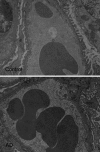Adriamycin alters glomerular endothelium to induce proteinuria
- PMID: 19073829
- PMCID: PMC2615716
- DOI: 10.1681/ASN.2007111205
Adriamycin alters glomerular endothelium to induce proteinuria
Abstract
The pathophysiology underlying the nephrotic syndrome is becoming clear for several inherited podocytopathies; the mechanisms of injury that lead to the acquired forms of this disease are not well understood. We explored these mechanisms using the mouse model of adriamycin-induced proteinuria.We estimated the fractional clearances for FITC-Ficolls, albumin, and neutral albumin in cooled, isolated,perfused kidneys (cIPK) in situ. Treatment with adriamycin led to a significant increase in the fractional clearance of albumin and of Ficoll with radii larger than 20 A. Neutral albumin (33.4 A) and similarly sized Ficoll behaved similarly to each other. In addition, adriamycin led to a significant loss of charge density and size selectivity of the glomerular barrier. The thickness of the glomerular endothelial surface layer(i.e., or the glycocalyx) in adriamycin-treated animals was only 20% of that in normal animals. Finally,several proteoglycans were downregulated in isolated glomeruli. In summary, adriamycin thins the glomerular glycocalyx, perhaps by downregulating proteoglycan synthesis, and alters glomerular charge- and size selectivity. These data suggest that the glomerular endothelium may play a role in the pathogenesis of proteinuric renal diseases.
Figures










References
-
- Haraldsson B, Nyström J, Deen WM: Properties of the glomerular barrier and mechanisms of proteinuria. Physiol Rev 88: 451–487, 2008 - PubMed
-
- Comper WD, Haraldsson B, Deen WM: Resolved: Normal glomeruli filter nephrotic levels of albumin. J Am Soc Nephrol 19: 427–432, 2008 - PubMed
-
- Russo LM, Sandoval RM, McKee M, Osicka TM, Collins AB, Brown D, Molitoris BA, Comper WD: The normal kidney filters nephrotic levels of albumin retrieved by proximal tubule cells: Retrieval is disrupted in nephrotic states. Kidney Int, 71: 504–513, 2007 - PubMed
Publication types
MeSH terms
Substances
LinkOut - more resources
Full Text Sources
Other Literature Sources

